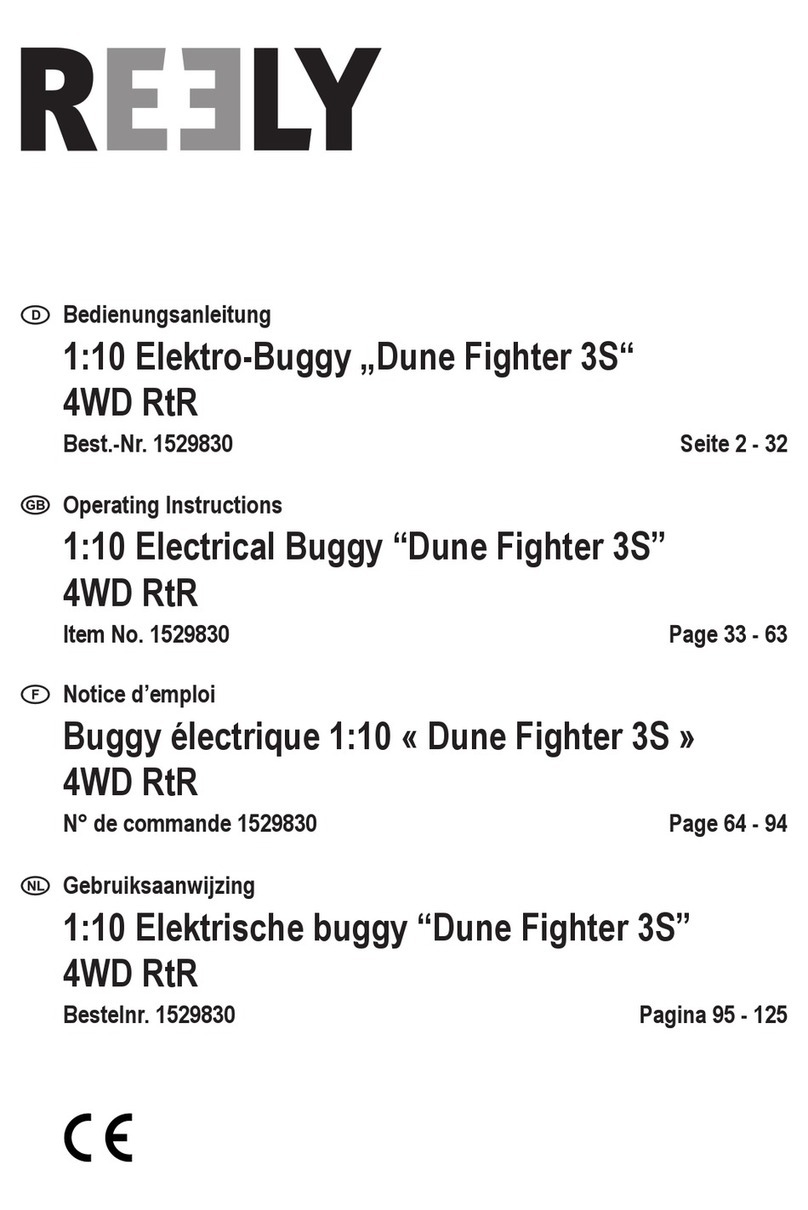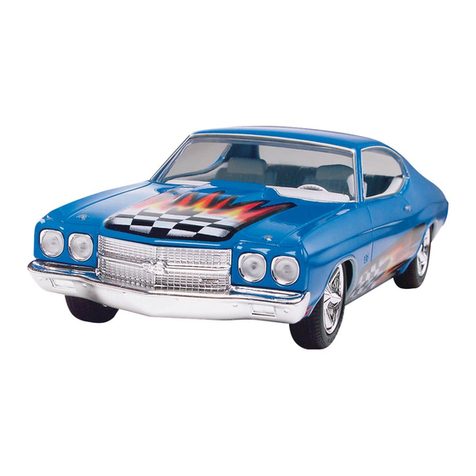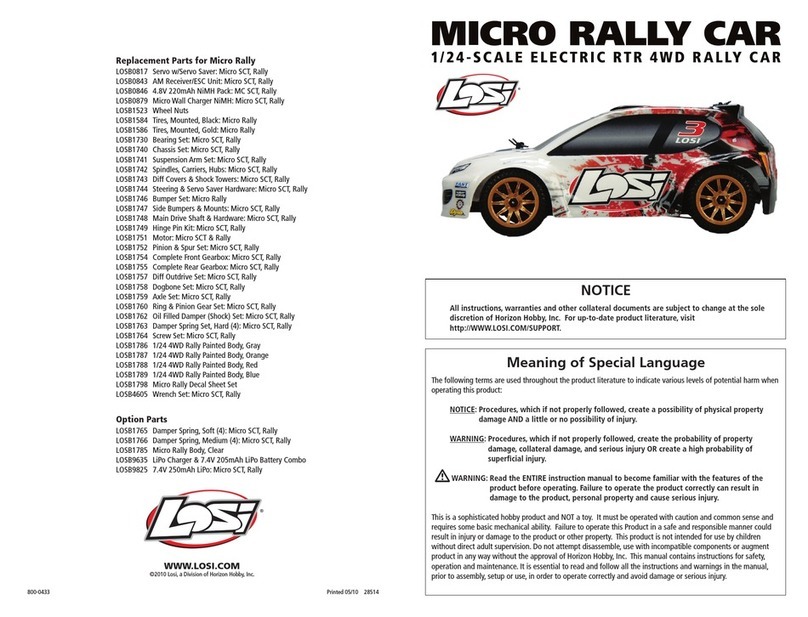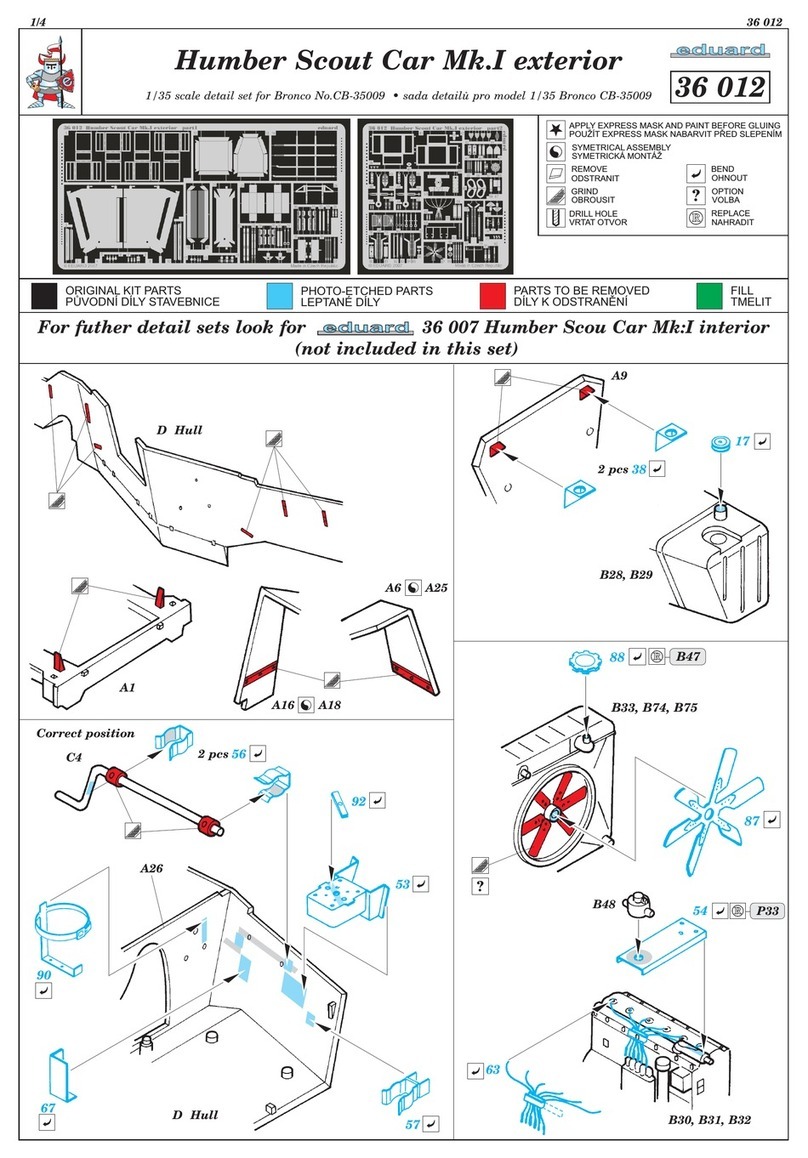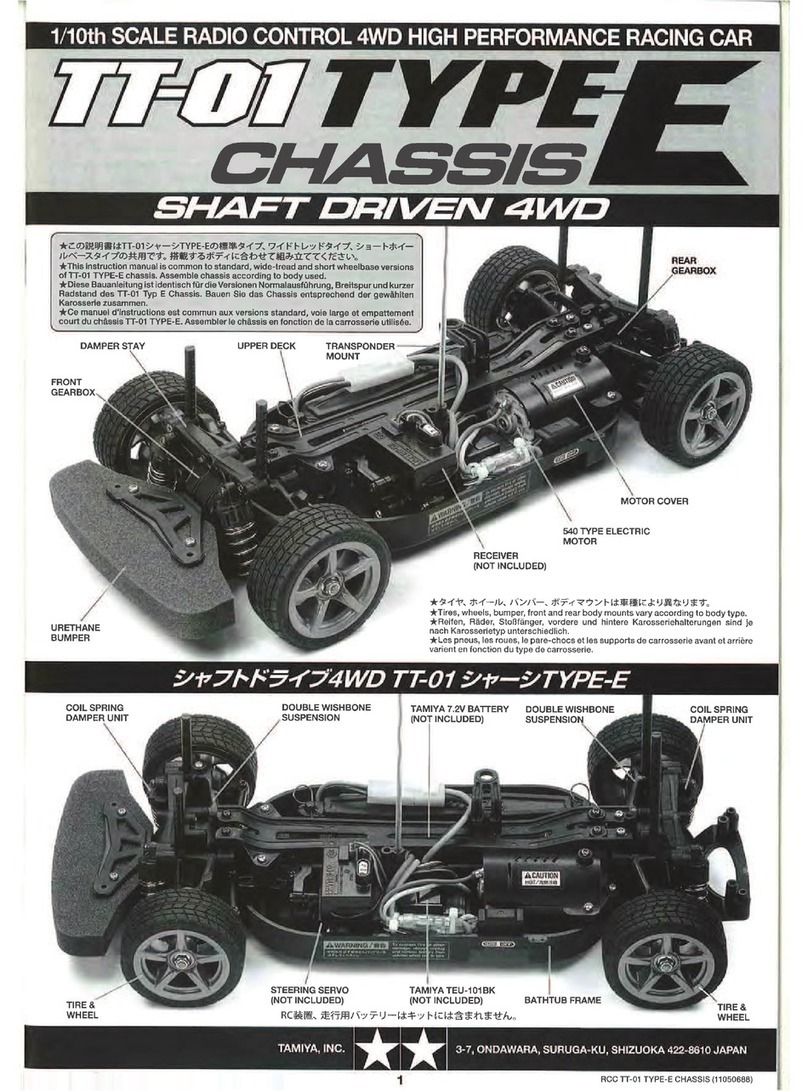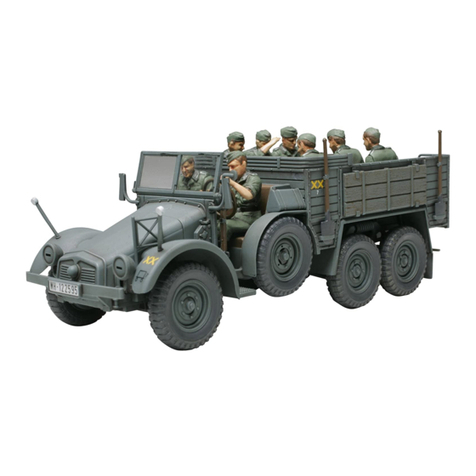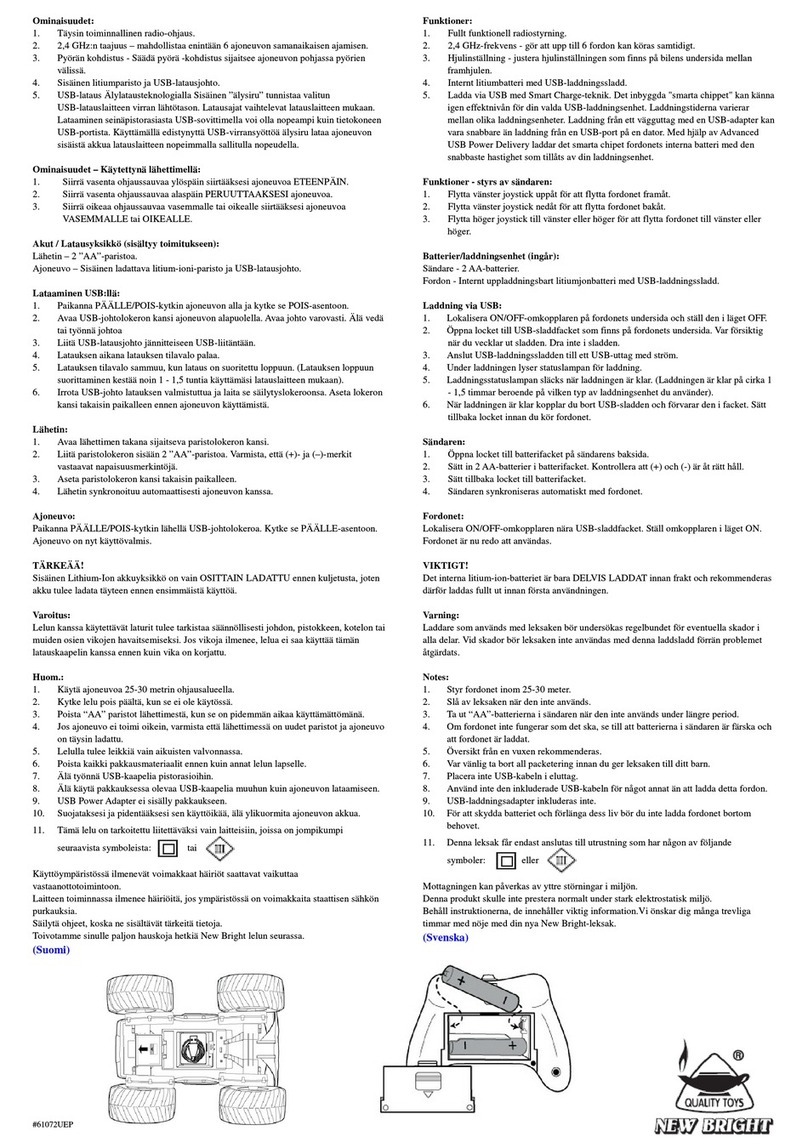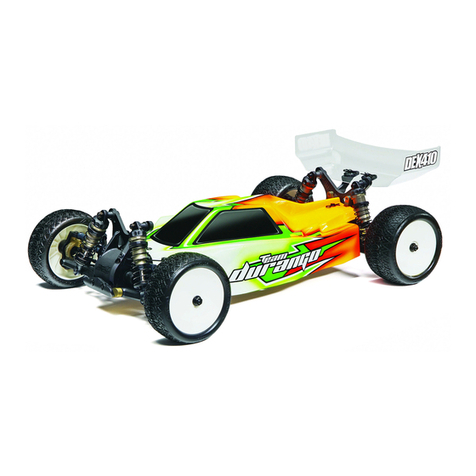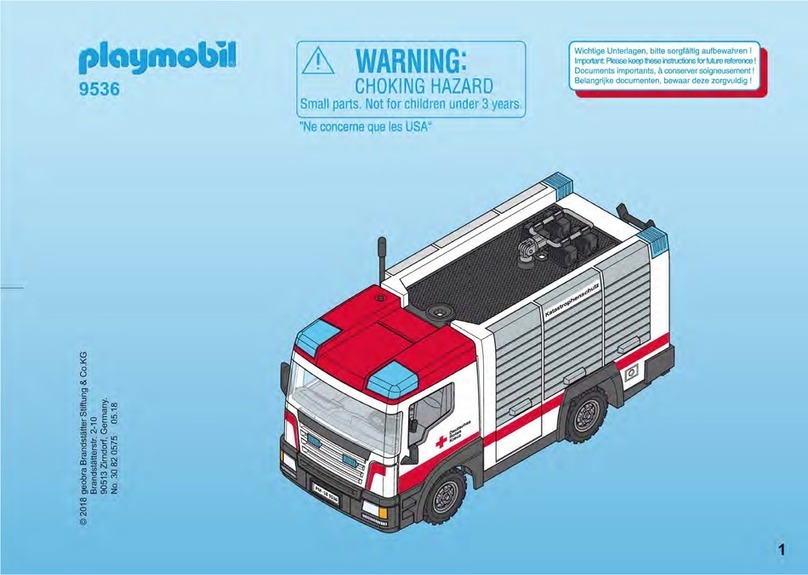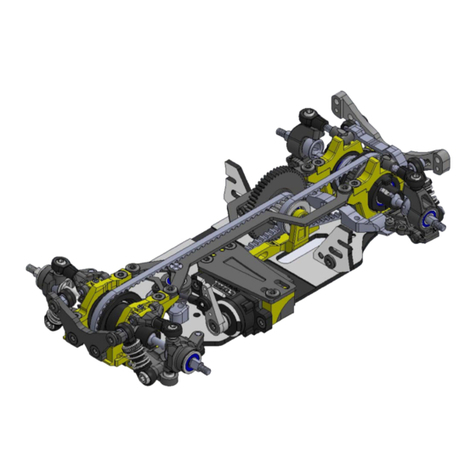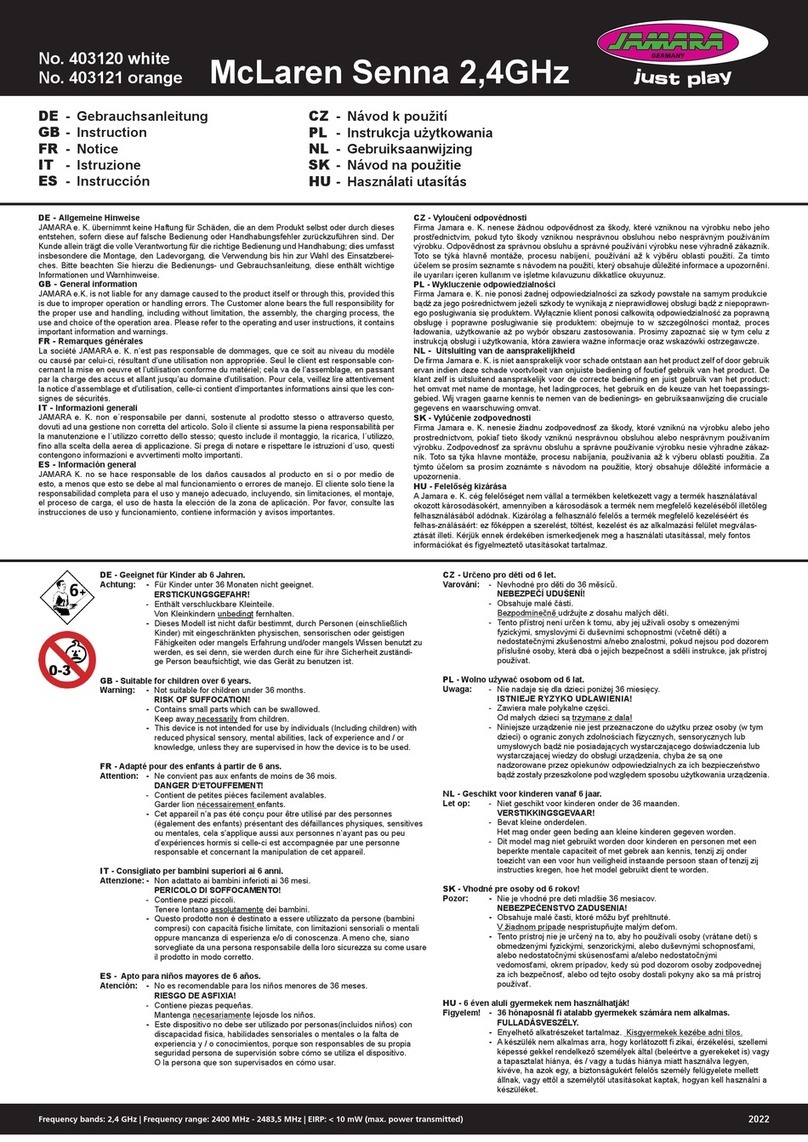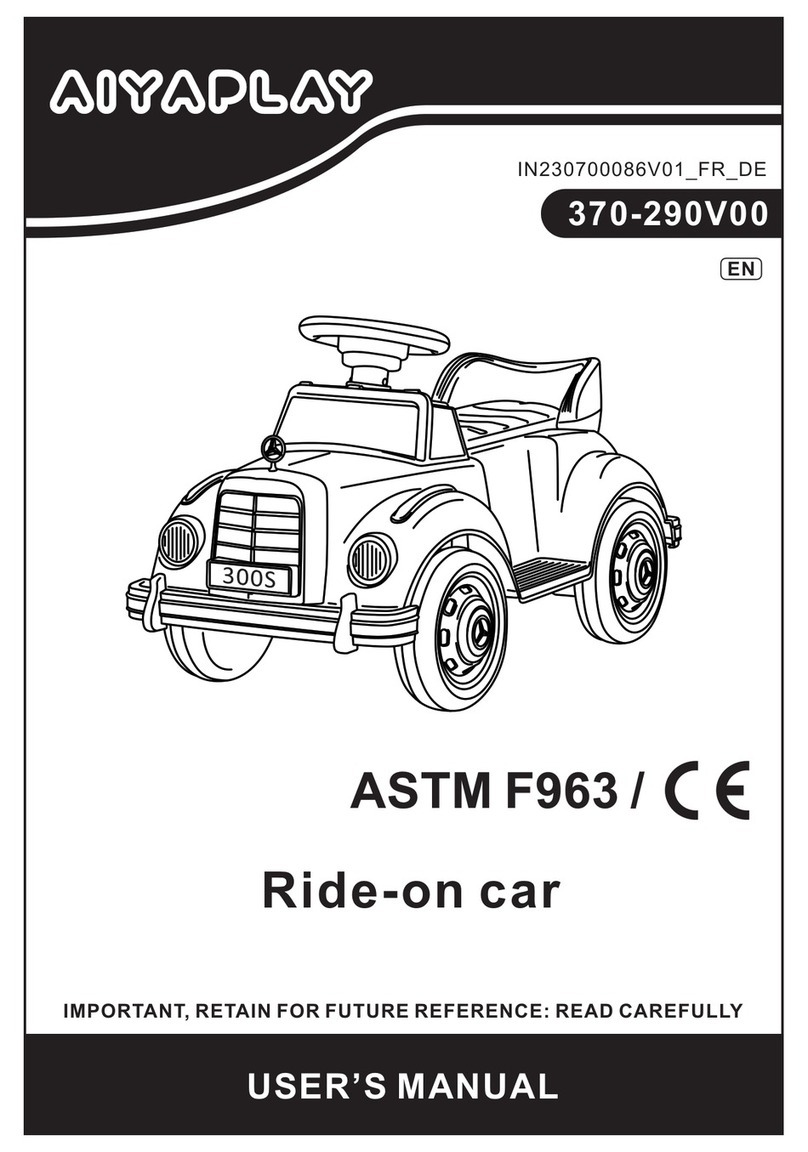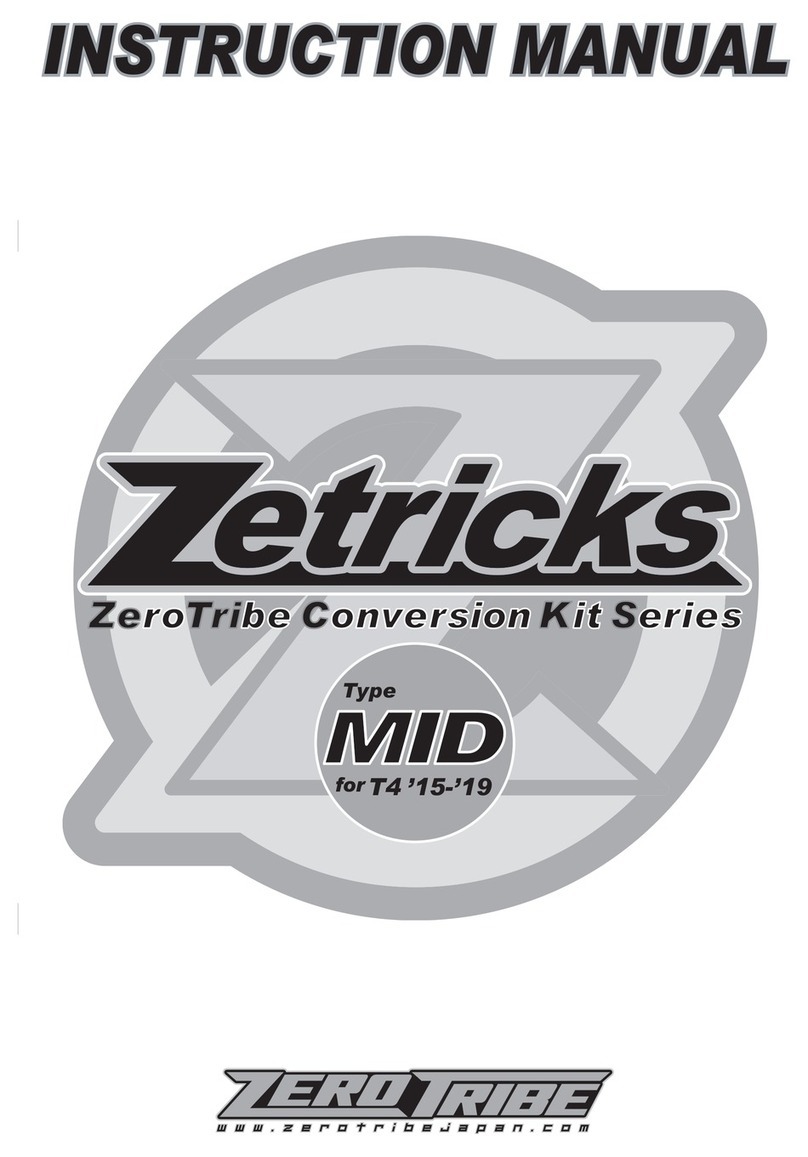Summit 5610 User manual

MODEL 5610
owner’
s manual

2 •Summit
3Before You Proceed
4Safety Precautions
5Tools, Supplies,
and Required
Equipment
6Anatomy of
the Summit
7Quick Start:
Getting Up
to Speed
8The Traxxas
TQ-4 Radio System
16 Adjusting the
Electronic Speed
Control
18 Driving Your Model
21 Tuning Adjustments
27 Maintaining
Your Model
Introduction
Thank you for purchasing the new Traxxas Summit electric monster
truck. The Summit is the most advanced electric monster truck
ever created, with multi-terrain capabilities that far exceed those of
any other monster truck. Designed from the start to optimize the
advantages of electric power, Summit builds on the success and
innovation of the E-Revo racing monster truck with the rst-ever
remote-locking differentials and transmitter-operated high-low
transmission for total mastery of any terrain without compromising
speed or handling.
This manual contains the instructions you will need to operate and
maintain your model so that you can enjoy it for years to come.
We want you to feel condent that you own one of the best-
performing models in the market and that it is backed by a team
of professionals who aim to provide the highest level of factory
support possible. Traxxas models are about experiencing total
performance and satisfaction, not just with your model, but also
with the company that stands behind it.
We know you’re excited about getting your new model on
the road, but it’s very important that you take some time to
read through the Owner’s Manual. This manual contains all the
necessary setup and operating procedures that allow you to unlock
the performance and potential that Traxxas engineers designed
into your model. Even if you are an experienced R/C enthusiast,
it’s important to read and follow the procedures in this manual.
Thank you again for going with Traxxas. We work hard every day
to assure you the highest level of customer satisfaction possible.
We truly want you to enjoy your new model!
Traxxas Support
Traxxas support is with you every step of the
way. Refer to the next page to nd out how to
contact us and what your support options are.
Quick Start
This manual is designed with a Quick
Start path that outlines the necessary
procedures to get your model up
and running in the shortest time possible. If you are an
experienced R/C enthusiast you will nd it helpful and fast.
Be sure and read through the rest of the manual to learn
about important safety, maintenance, and adjustment
procedures. Turn to page 7 to begin.

Summit • 3
Before You Proceed
Carefully read and follow all instructions in this and any
accompanying materials to prevent serious damage to your
model. Failure to follow these instructions will be considered
abuse and/or neglect.
Before running your model, look over this entire manual and
examine the model carefully. If for some reason you decide it is not
what you wanted, then do not continue any further. Your hobby
dealer absolutely cannot accept a model for return or exchange
after it has been run.
Warnings, helpful hints, & cross-references
Throughout this manual, you’ll notice warnings and helpful hints
identied by the icons below. Be sure to read them!
An important warning about personal safety or avoiding
damage to your model and related components.
Special advice from Traxxas to make things easier
and more fun.
Refers you to a page with a related topic.
Support
If you have any questions about your model or its operation,
call the Traxxas Technical Support line toll-free at:
1-888-TRAXXAS (1-888-872-9927)*
Technical support is available Monday through Friday from 8:30am
to 9:00pm Central Standard Time. Technical assistance is also
available at Traxxas.com. You may also e-mail customer support
with your questions at [email protected]. Join thousands of
registered members in our online community at Traxxas.com.
Traxxas offers a full-service, on-site repair facility to handle any
of your Traxxas service needs. Maintenance and replacement
parts may be purchased directly from Traxxas by phone or online
at BuyTraxxas.com. You can save time, along with shipping
and handling costs, by purchasing replacement parts from your
local dealer.
Do not hesitate to contact us with any of your product support needs.
We want you to be thoroughly satised with your new model!
Traxxas
1100 Klein Road
Plano, Texas 75074
Phone: 972-265-8000
Toll-free 1-888-TRAXXAS
Traxxas U.K.
P.O. Box 1128
Winterbourne, Bristol
BS36-2SH
England
Phone: 44-117-956-1002
Internet
Traxxas.com
E-mail: [email protected]
Entire contents ©2009 Traxxas.
Traxxas, Ready-To-Race, TQ, Titan,
Summit and EVX-2 are trademarks
or registered trademarks of
Traxxas. Other brand names and
marks are the property of their
respective holders and are used
only for purposes of identication.
No part of this manual may be
reproduced or distributed in print
or electronic media without the
express written permission of
Traxxas. Specications are subject
to change without notice.
*Toll-free support is available to U.S. residents only.

4 •Summit
This model is not intended
for use by children under
8 years of age without the
supervision of a responsible
and knowledgeable adult.
All instructions and
precautions outlined in this
manual should be strictly
followed to ensure safe
operation of your model.
Safety Precautions
Previous experience with
radio controlled models
is recommended. Models
require a higher level of
setup, maintenance, or
support equipment.
Skill Level = Myriad Semi Bold
1 2 3 3+ 4 5
bluehighway font
ForExpert Drivers
Choose the Model That is Right For You. For individual Models
No previous experience with radio controlled models is required.
Models require a minimum of setup, maintenance, or support equipment.
Previous experience with radio controlled models is mandatory. These
models are capable of high speeds, requiring experienced driving control.
Models require detailed setup, and/or maintenance procedures with required
support equipment.
Previous experience with radio controlled models is mandatory.
These models are capable of very high speeds and require an even higher
level of skilled driving control. Models require detailed setup, and/or mainte-
nance procedures with required support equipment.
For Expert Drivers Only. This product is capable of extreme speed
and acceleration! It carries our highest skill level rating and is intended
for expert drivers only. Experience with nitro-powered radio controlled
models is required!
Previous experience with radio controlled models is recommended.
Models require a higher level of setup, maintenance, or support equipment.
No previous experience with radio controlled models is required.
Model requires a minimum of setup, maintenance, or support equipment.
Previous experience with radio controlled models is mandatory. This model is
capable of high speeds, requiring experienced driving control. Model requires
detailed setup, and/or maintenance procedures with required support
equipment.
Previous experience with radio controlled models is mandatory. This model is
capable of very high speeds and requires an even higher level of skilled driving
control. Model requires detailed setup, and/or maintenance procedures with
required support equipment.
For Expert Drivers Only. This product is capable of extreme speed
and acceleration! It carries our highest skill level rating and is intended
for expert drivers only. Experience with nitro-powered radio controlled
models is required!
Previous experience with radio controlled models is recommended.
Model requires a higher level of setup, maintenance, or support equipment.
BELOW TEXT HAS BEEN UPDATED on 3-14-07
Kent wants maintenance text to be at the END of the paragraph.-- KB
All of us at Traxxas want you to safely enjoy your new model.
Operate your model sensibly and with care, and it will be exciting,
safe, and fun for you and those around you. Failure to operate your
model in a safe and responsible manner may result in property
damage and serious injury. The precautions outlined in this manual
should be strictly followed to help ensure safe operation. You alone
must see that the instructions are followed and the precautions are
adhered to.
Important Points to Remember
Your model is not intended for use on public roads or in
congested areas where its operation can conict with or disrupt
pedestrian or vehicular trafc.
Never, under any circumstances, operate the model in crowds of
people. Your model is very fast and could cause injury if allowed
to collide with anyone.
Because your model is controlled by radio, it is subject to radio
interference from many sources that are beyond your control.
Since radio interference can cause momentary losses of radio
control, always allow a safety margin in all directions around the
model in order to prevent collisions.
The motor, batteries, and speed control can become hot during
use. Be careful to avoid getting burned.
Do not operate your Summit in conditions that limit your line
of sight or impair your ability to see the model. Do not rely on
Summit’s LED lighting system as the only source of illumination
for your driving area if you choose to drive after dark.
Most importantly, use good common sense at all times.
Batteries and Battery Charging
Your model uses rechargeable batteries that must be handled with
care for safety and long battery life. Make sure to read and follow all
instructions and precautions that were provided with your battery
packs and your charger. It is your responsibility to charge and care
for your battery backs properly. In addition to your battery and
charger instructions, here are some more tips to keep in mind.
Never leave batteries to charge unattended.
Remove the batteries from the model while charging.
Always unplug the batteries from the electronic speed control when
the model is not in use and when it is being stored or transported.
Allow the battery packs to cool off between runs
(before charging).
Do not use battery packs that have been damaged in any way.
Do not use battery packs that have damaged wiring, exposed
wiring, or a damaged connector.
Children should have responsible adult supervision when
charging and handling batteries.
Speed Control
Disconnect the Batteries: Always disconnect the batteries from the
speed control when not in use.
Transmitter on First: Switch on your transmitter rst before
switching on the speed control to prevent runaways and
erratic performance.
Don’t Get Burned: The heat sink can get extremely hot, so be
careful not to touch it until it is cool. Supply adequate airow
for cooling.
Use Stock Connectors: If you decide to change the battery
or motor connectors, only change one battery or motor connector
at a time. This will prevent damage from accidentally mis-wiring
the speed control. Please note that modied speed controls can
be subject to a rewiring fee when returned for service. Removing
the battery connector on the speed control or using connectors
with no reverse-polarity protection on the speed control will void
the product’s warranty.
Insulate the Wires: Always insulate exposed or damaged wiring
with heat shrink tubing to prevent short circuits
Always Use Heat Sinks: Three heat sinks are factory-installed on
the speed control and must be used for maximum cooling and
performance.
No Reverse Voltage: The speed control is not protected against
reverse polarity voltage. When changing the battery and/or
motor, be sure to install the same type of connectors to avoid
reverse polarity damage to the speed control. Removing the
battery connectors on the speed control or using the same-gender
connectors on the speed control will void the product’s warranty.
Do Not Let the Transistor Tabs Touch: Never allow the three
separate transistor banks to touch each other or any exposed
metal. This will create a short circuit and damage the speed
control. (For example, laying a metal tool across the heat sinks can
damage the speed control.)
No Schottky Diodes: External Schottky diodes are not compatible
with reversing speed controls. Using a Schottky diode with the
EVX-2 will damage the ESC and void the 30-day warranty.
1

Summit • 5
Tools, Supplies, and Required Equipment
Your model comes with a set of specialty metric tools. You’ll need to purchase other items, available from your hobby dealer, to operate
and maintain your model.
Required Tools and Equipment (sold separately)
8 AA alkaline
batteries
Recommended Equipment
These items are not required
for the operation of your
model, but are a good idea to
include in any R/C toolbox:
• Safety glasses
• Thin, hobby-quality
cyanoacrylate instant tire
glue (CA glue)
• Hobby knife
• Side cutters and/or needle
nose pliers
• Philips screwdriver
• Soldering iron
For more information on
batteries, see Use the Right
Batteries on page 10.
A peak-detecting charger
is recommended for best
performance and longest
battery life. For more
information, see Use the
Right Charger on page 12.
Two NiMH battery packs (7.2V 6-cell
or 8.4V 7-cell [recommended])
NiMH battery charger
(peak detecting type recommended - see sidebar)
Warning: Lithium Polymer (LiPo) batteries should not be used with the EVX-2. The EVX-2 electronic speed control is not equipped with low-voltage detection.
SUPPLIED TOOLS AND EQUIPMENT
TRAXXAS
Glow plug
wrench 2.0mm “T” wrench 2.5mm “T” wrench
Shock wrench 5mm turnbuckle wrench Suspension multi-tool 4-way wrench
3.0mm “L” wrench
Antenna nut wrench
Body clips Battery Retainers
17mm wheel
wrench

Toe Link
(Turnbuckle)
6 •Traxxas
Anatomy of the Summit
Rear Half
Shaft
Transmission
Chassis
Transmission Shifting Servo Rear T-Lock
Servo
Front T-Lock Servo
Antenna Mount
Differential Locking Controller
(inside box)
Front
Suspension
Arm
Front
Bumper
Rear
Bumper
Oil Shock
(Damper)
Rear Body
Mount
Hex Hub
Rear Suspension
Arm
Axle Carrier
Pivot Ball
Toe Link
(Turnbuckle)
Receiver Box
Skid Plate
Steering Servo
Steering Servo
Front Body
Mount
Battery Compartment
Door
Battery
Compartment
Vent
Electronic Speed
Control (EVX-2)
Motor (Titan 775)
Battery Door Release Tab
Slipper Clutch
Rocker
Rocker
Push Rod
Push Rod
Spring Pre-load
Adjuster
Traxxas
High-Current
Connector

Summit • 7
Quick Start: Getting up to Speed
The following guide is an overview of the procedures for getting your model running. Look for the Quick Start logo on the bottom
corners of Quick Start pages.
1. Read the safety precautions on page 4 9. Detail your model • See page 9
For your own safety, understand where carelessness and misuse
could lead to personal injury.
Apply other decals if desired.
2. Charge the battery packs • See sidebar, page 12 10. Drive your model • See page 18
Fully charge two 7.2 or 8.4-volt battery packs (not included). Charge the bat-
teries now so they will be ready when you finish the other setup procedures.
Driving tips and adjustments for your model.
3. Install the antenna • See page 11 11. Maintaining your model • See page 27
Install the antenna mast in the model. Follow these critical steps to maintain the performance
of your model and keep it in excellent running condition.
4. Install batteries in the transmitter • See page 11
The transmitter requires 8 AA alkaline or rechargeable batteries.
5. Install battery packs in the model • See page 12
Your model requires two fully charged 7.2 or 8.4-volt battery packs
(not included).
6. Turn on the radio system • See page 15
Make a habit of turning the transmitter on rst, and off last.
7. Check servo operation • See page 15
Make sure the steering servos are working correctly.
8. Range test the radio system • See page 15
Follow this procedure to make sure your radio system works properly
at a distance and that there is no interference from outside sources.
The Quick Start Guide is
not intended to replace the
full operating instructions
available in this manual.
Please read this entire
manual for complete
instructions on the proper
use and maintenance of
your model.
Look for the Quick Start
logo at the bottom of
Quick Start pages.

8 •Summit
The Traxxas TQ-4 Radio System
Your model is equipped with the Traxxas TQ-4 Radio System. The Traxxas TQ-4 Radio System is a 4-channel system that provides high-power
output up to a quarter mile. As installed in the Summit, the TQ-4 transmitter operates dual steering servos (channel 1), the electronic speed
control (channel 2), transmission shift servo (channel 3) and T-Lock actuator servos (channel 4).
TQ-4 Transmitter
Antenna
High/Low Gear
Transmission Shift
Steering Trim
Throttle Trim
Throttle
Trigger
Throttle Neutral Adjust
Steering Wheel
Power Switch Battery Compartment
Servo
Reversing
Switch
T-Lock
Switch
Power Indicator
16.8V ESC
WATERPROOF
To Motor
LED EZ-Set Button
Heat Sinks
EVX-2 Electronic Speed Control
EVX-2 Wiring Diagram
High-Current
Battery Connector

Summit • 9
Applying The Decals
The main decals for your
model have been applied at
the factory. The decals are
printed on self-adhesive clear
mylar and are die-cut for easy
removal. Use a hobby knife
to lift the corner of a decal
and lift it from the backing.
To apply the decals, place one
end down, hold the other end
up, and gradually smooth the
decal down with your nger
as you go. This will prevent air
bubbles. Placing both ends
of the decal down and then
trying to smooth it out will
result in air pockets.
Look at the photos on the box
for typical decal placement.
16.8V ESC
WATERPROOF
Summit Wiring
Antenna
to
LED Lights
Receiver
Crystal
Motor
(Titan® 775)
High-Current
Connector
Channel 2
EVX-2 Electronic
Speed Control
Channel 1
Steering Servos
Channel 3
Shift Servo
Front T-Lock Servo
(DLC output A)
Rear T-Lock Servo
(DLC output B)
Channel 4
Differential Locking
Controller (DLC)
The Traxxas TQ-4 Radio System
9

10 •Summit
The Traxxas TQ-4 Radio System
Use the Right Batteries
Your transmitter uses AA
batteries. Use new alkaline
batteries, or rechargeable
batteries such as NiCad
or NiMH (Nickel Metal
Hydride) batteries in your
transmitter. Make sure
rechargeable batteries are
fully charged according
to the manufacturer’s
instructions.
If you use rechargeable
batteries in your
transmitter, be aware
that when they begin
to lose their charge, they
lose power more quickly
than regular alkaline
batteries.
Caution: Discontinue
running your model at the
rst sign of weak batteries
(ashing red light) to avoid
losing control.
Radio System Terminology
Please take a moment to familiarize yourself with these radio-
system terms. They will be used throughout this manual.
BEC (Battery Eliminator Circuit) - The BEC can either be in the
receiver or in the ESC. This circuit allows the receiver and servos
to be powered by the main battery pack in an electric model. This
eliminates the need to carry a separate pack of 4 AA batteries to
power the radio equipment.
Channel - The 27 MHz frequency band is divided into 6 channels
so that up to six models can be operated simultaneously. Each
channel is referred to by its ag color and channel number, as
shown below.
Clearing your frequency - A routine, verbal check to make sure
nobody else in your area is operating on the same channel.
Always clear your frequency by calling out your channel number
before operating your model. Wait or move to another area if
your channel is already being used.
Crystal (X-tal) - The plug-in device that determines which channel
the radio system will operate on. For each channel, there are two
crystals, one for the receiver and one for the transmitter. Of those
two crystals, the one marked with the lower number (.455 MHz
lower) must be inserted into the receiver.
ESC (Electronic Speed Control) - An electronic speed control is
the electronic motor control inside the model. The EVX-2 uses
MOSFET power transistors to provide precise, digital proportional
throttle control. Electronic speed controls use power more
efciently than mechanical speed controls so that the batteries
run longer. An electronic speed control also has circuitry that
prevents loss of steering and throttle control as the batteries lose
their charge.
Frequency band - The radio frequency used by the transmitter to
send signals to your model. All Traxxas RTR models operate on a
27 MHz frequency band.
mAh – Abbreviation for milliamp hour. A measure of the capacity of
the battery pack. The higher the number, the longer the battery
will last between recharges.
Neutral position - The standing position that the servos seek when
the transmitter controls are at the neutral setting.
NiCad - Abbreviation for nickel-cadmium. The original rechargeable
hobby pack, NiCad batteries have very high current handling,
high capacity, and can last up to 1000 charging cycles. Good
charging procedures are required to reduce the possibility of
developing a “memory” effect and shortened run times.
NiMH - Abbreviation for nickel-metal hydride. Rechargeable
NiMH batteries offer high current handling, and much greater
resistance to the “memory” effect. NiMH batteries generally
allow higher capacity than NiCad batteries. They can last up to
500 charge cycles. A peak charger designed for NiMH batteries is
required for optimal performance.
Receiver - The radio unit inside your model that receives signals
from the transmitter and relays them to the servos.
Servo - Small motor unit in your model that operates the steering
mechanism.
Transmitter - The hand-held radio unit that sends throttle and
steering instructions to your model.
Trim - The ne-tuning adjustment of the neutral position of the
servos, made by adjusting the throttle and steering trim sliders
on the face of the transmitter.
Thermal Shutdown Protection - Temperature sensing electronics
are used in the ESC to detect overloading and overheating of the
transistor circuitry. If excessive temperature is detected, the unit
automatically shuts down to prevent damage to the electronics.
4-channel radio system - The TQ-4 radio system, consisting of the
transmitter, receiver and servos.
775 motor – A motor’s number refers to its size; for example, a 550
is larger than a 540. Summit’s 775 motor is the largest offered in
an electric monster truck.
T-Lock – Traxxas’ proprietary remote differential locking system.
DLC – Differential Locking Controller. This electronic component
operates the T-Lock system’s servos as commanded by the
T-Lock switch on the transmitter.
Channel Frequency
Band
Flag
Color
Traxxas
Part No.
1 26.995 Brown 2031
2 27.045 Red 2032
3 27.095 Orange 2033
4 27.145 Yellow 2034
5 27.195 Green 2035
6 27.255 Blue 2036

Summit • 11
The Traxxas TQ-4 Radio System
Installing Transmitter Batteries
Your TQ-4 transmitter uses 8 AA batteries (see sidebar, page 10).
The battery compartment is located in the base of the transmitter.
1. Remove the battery compartment door by pressing the tab and
lifting the door up.
2. Install the batteries in the correct orientation as indicated in the
battery compartment.
3. Reinstall the battery door and snap it closed.
4. Turn on the transmitter and check the power indicator for a solid
red light.
If the power indicator light ashes, then the transmitter batteries
are weak, discharged or possibly installed incorrectly. Replace with
new or freshly charged batteries. The power indicator light does not
indicate the charge level of the battery pack installed in the model.
Setting up the Antenna
1. Locate the black antenna wire that
exits the receiver box.
2. Pull the wire straight with your
ngers and then insert the end of
the wire into one end of the antenna
tube (the antenna tube, tip, crimp
nut and sleeve are located in the
documents bag). Push the wire all the
way through the antenna tube.
3. Insert the base of the tube into the
antenna post. Take care not to crimp
the antenna wire.
4. Slide the crimp nut over the antenna
tube and screw it onto the antenna
post. Use the supplied tool to tighten
the crimp nut on the post just until
the antenna tube is securely in place.
Do not over tighten or crush the
antenna wire against the chassis.
5. Fold the top of the antenna wire over
the top of the antenna tube. Slide
the antenna tip onto the top of the
antenna tube. Never cut or shorten
the antenna wire.
6. On the transmitter, always fully
extend the telescoping antenna
when running your model. Make a
habit of holding the transmitter so
the antenna points straight up.
If the power indicator
doesn’t light red, check the
polarity of the batteries.
Check rechargeable
batteries for a full charge.
Spray a little window cleaner
on the antenna wire to make
it easier to push through the
antenna tube.
Don’t shorten the length of
the antenna wire. Its length
is tuned to the frequency
band; cutting it could
severely shorten the radio
system’s range.
If there are any kinks in the
black antenna wire, it will
be more difcult to push
through the antenna tube.
Pull the wire straight by
sandwiching it between your
thumb and index nger and
running your ngers along
the length of the wire (with
medium pressure).
Antenna
Tip
Antenna
Tube
Antenna
Wrench
Antenna
Crimp Nut
Antenna
Post
See page 20 for more
information about the
receiver box and maintaining
a watertight seal.
3&4

12 •Summit
The Traxxas TQ-4 Radio System
Installing Battery Packs
The Summit requires two fully charged 7.2 or 8.4-volt (stick style)
NiMH battery packs. These batteries are not included with the model.
For the best performance, use 8.4-volt (7-cell) NiMH battery packs.
Using Different Battery Congurations
The battery compartments in the Summit are adjustable to
accommodate a large variety of battery packs. From the factory, the
battery compartments are congured to accept most common 7-cell
NiMH stick packs.
The Summit battery compartments have three key features for
keeping your batteries secure:
1. A foam rubber cushion
2. A spring clip. This is removable for use with taller batteries.
3. A battery retainer tab. This is adjustable to t a variety of battery sizes.
We recommend using this combination for all NiMH batteries. Make
sure to adjust the battery retainer tab to keep your battery pack snug
against the foam rubber cushion. This does not need to be very
tight. It only needs to prevent the battery from moving excessively
during use.
Battery Installation
1. Open the battery
compartment door
by pressing on the
release tabs.
2. Install the battery
pack with the battery wires facing the rear of the model.
3. Make sure the battery is snug in the compartment. If not, remove
battery and make
adjustment to the
battery retainer tab.
4. Route the battery
wire through the slot
near the vent.
5. Close the battery door, making sure not to pinch the battery wires.
Be sure both release tabs are fully engaged with the door. Do not
connect the battery packs to the EVX-2 at this time. Note: always
unplug the batteries and remove from the model after use.
6-cell battery packs:
Swap the battery
retainer tabs from the
left and right battery
compartments. This
will provide additional
adjustment needed to
keep the 6-cell battery packs snug against the foam rubber cushions.
Adjusting Battery Position
The best handling and performance is achieved when the batteries
are positioned to the front of the battery compartment (against the
foam rubber cushion). However, you can reposition the batteries to
change the weight distribution and handling if desired. The Summit
includes an extra set
of battery retainer tabs
that can be used in the
front of the battery
compartment to move
the batteries toward the
rear of the truck.
When using the battery
retainer tabs in the front of the battery compartment, use two
3x10 countersunk cap screws to retain each battery retainer tab.
Do not use the battery retainer tabs in the front of the battery
compartments when using LiPo batteries that are not in a hard
plastic case (The EVX-2 is not compatible with LiPo batteries, see
information below about using LiPo batteries).
Using LiPo Battery Packs in your Summit
Warning: The EVX-2 electronic speed control is not directly
compatible with LiPo batteries. The EVX-2 electronic speed control
is not equipped with low-voltage detection. For LiPo use, the
EVX-2 power system requires an external low voltage detector for
each battery pack (sold separately, consult your hobby dealer). If
you are using an aftermarket electronic speed control, consult the
manufacturer’s instructions for information about LiPo compatibility.
Use the Right Charger
The most convenient type
of charger is an AC peak-
detecting charger that plugs
directly into an AC wall
outlet. It contains special
peak-detection circuitry
that automatically shuts the
charger off when the battery
is fully charged.
If you’re using a 15-minute
timed charger, always fully
discharge the battery pack
before each charge. Some
high mAh battery packs
(1500 mAh or higher) require
more than the standard 15
minutes of charge time. If
the battery pack is cold after
15 minutes of charging,
add another 5 minutes of
charge time. Closely monitor
the battery pack and stop
charging it when it begins
to feel warm to the touch.
Never leave a battery
charging unattended.
Always follow charger
manufacturer’s instructions.
Foam
Cushion
Retainer
Tab
Spring
Clip
6-cell Battery Orientation
Battery Wire Slot
7-cell Battery Orientation
Alternate Rear Position
6-cell Battery Orientation
Retainer Tabs
2&5

Summit • 13
The Traxxas TQ-4 Radio System
The battery compartments can be recongured to accept many sizes
of LiPo batteries. If you are using batteries that are very thick, the
spring clip may need to be removed from the battery compartment.
Spring Clip Removal
1. Pull down on the inside
of the clip.
2. Push the clip in toward
the center of the model
to release.
Spring Clip Installation
1. Insert the two tabs on
the spring clip into the
rectangular tab slots in
the chassis.
2. Rotate the spring
clip upward.
3. Snap the tabs into place.
Many LiPo batteries do not use a hard plastic case. If using LiPo
batteries that do not have a hard case, always be sure to use the
foam rubber cushion in the front of the battery compartment.
Do not use the battery retainer tabs in the front of the battery
compartments when using LiPo batteries that are not in a hard
plastic case. A hard front impact or crash when driving can damage
the LiPo batteries.
The Traxxas High Current Connector
Your model is equipped with the Traxxas
High-Current Connector. Standard
connectors restrict current ow and
are not capable of delivering the
power needed to maximize the output
of the EVX-2. The Traxxas connector’s gold-plated terminals with
a large contact surfaces ensure positive current ow with the
least amount of resistance. Secure, long-lasting, and easy to grip,
the Traxxas connector is engineered to extract all the power your
battery has to give.
To run this model, your batteries must be equipped with Traxxas
High-Current Connectors. Batteries can either be purchased new
with Traxxas connectors installed or Traxxas connectors can be
purchased to install on battery packs you already own. See sidebar
for packages available from your hobby dealer.
The typical Molex style connector is inadequate for
use in your model. It creates resistance that becomes
a bottleneck to current ow. If your battery pack
is equipped with a Molex connector, it must be
replaced with a Traxxas High-Current Connector to
mate with the EVX-2 electronic speed control. Molex
connector
The following Traxxas High
Current Connector packages
are available from your
hobby dealer. When using
adapters, be careful not to
exceed the current rating of
the Molex connector.
Part #3060
Single Male/Female
Part #3080
2-Pack Female
Part #3070
2-Pack Male
Part #3061
Male Charge Adapter
Part #3062
Female Charge Adapter

14 •Summit
Don’t push the transmitter
antenna down from the
top. Pull it down from the
bottom, one segment at a
time, to prevent binding and
kinking the antenna mast.
TQ-4 Radio System Adjustments
In addition to the electronic throttle and steering trim controls,
your radio system features throttle neutral adjustment and servo
reversing switches. These are preset at the factory and should
not require further adjustment.
Throttle Neutral Adjustment
The throttle neutral adjustment is located on the transmitter face
and controls the forward/reverse travel of the throttle trigger.
Change the adjustment by pressing the button and sliding it to
the desired position.
There are two settings available:
50/50: Allows equal travel for both
acceleration and reverse.
70/30: Allows more throttle travel (70%)
and less reverse travel (30%).
Note: If you change throttle travel, you
will need to reprogram the electronic
speed control.
Electronic Throttle Trim
The electronic throttle trim located on the face of the transmitter
adjusts the neutral (center) point of the electronic speed control.
This control has been preset for you at the factory.
Electronic Steering Trim
The electronic steering trim located on the face of the transmitter
adjusts the neutral (center) point of the steering servos when the
servos are at rest. Adjust this control to make the model drive
straight with no steering input at the wheel.
T-Lock switch
This switch controls the T-Lock system. When in the “up” position,
both differentials are unlocked. Move the switch to the middle
position to lock the front differential. To lock both differentials,
move the switch to the “down” position.
High-Low Ratio Selector
The red rocker switch shifts the transmission from Low to High.
Push in the top of the switch to engage Low. Push in the bottom
of the switch to engage High.
Servo Reversing Switches
The servo reversing switches
are located on the front of the
transmitter, next to the on/off
switch. Moving a switch reverses the
direction of the corresponding servo.
Each switch corresponds to a
channel, as shown below. For
example, if you turn the steering
wheel to the right and your wheels
turn left, you would move the
Channel 1 switch to correct the
servo direction. It may be necessary
to adjust the corresponding trim
control after moving a switch.
TQ-4 Radio System Controls
Channel
1
2
3
4
Servo
Steering
Throttle
Shifting
Diff Locking
Default Setting
The Traxxas TQ-4 Radio System

Summit • 15
Your speed control was
adjusted to the radio from
the factory. It is possible
for the throttle trim control
on the transmitter to have
moved during transit
or while handling the
transmitter. If the motor
runs when the model is
switched on, then move the
throttle trim control on the
transmitter until the motor
stops. If anything more
than a slight adjustment of
the throttle trim control is
required, then you should
readjust your speed control.
Refer to the adjustments
section on page 16.
Remember, always turn the
TQ-4 transmitter on rst and
off last to avoid damage to
your model.
When rechargeable batteries
begin to lose their charge,
they will fade much faster
than alkaline dry cells. Stop
immediately at the rst sign
of weak batteries. Never turn
the transmitter off when the
battery pack is plugged
in. The model could run out
of control.
TQ-4 Radio System Rules
Each time you prepare to run your model, you
must clear your frequency to be sure no one
else in the area is using the same channel as
you. There are six possible channels, numbered
1 through 6. Each is represented by a color.
Look at the crystal plugged into the back of
your transmitter to determine which channel
your model is assigned to.
Always turn your TQ-4 transmitter on rst and
off last. This procedure will help to prevent your model
from receiving stray signals from another transmitter,
or other source, and running out of control.
Always have the transmitter turned on before plugging in
the batteries.
Always use new or freshly charged batteries for the radio
system. Weak batteries will limit the range of the radio signal
between the receiver and the transmitter. Loss of the radio
signal can cause you to lose control of your model.
TQ-4 Radio System Setup
The TQ-4 Radio System was pre-adjusted at the factory. The
adjustment should be checked, before running the model,
in case of movement during shipping. Here’s how:
1. Fully extend the chrome antenna mast on the transmitter and
turn the switch on. The red indicator light on the transmitter
should be solid red (not ashing).
2. Elevate the model so that all four tires are off the ground.
If you are holding the model, grip it rmly by the front and rear
bumpers. Make sure hands and clothing are clear of the wheels
and other moving parts on the model.
3. Plug the battery packs in the model into the speed control.
4. The on/off switch is integrated into the speed control. With
the transmitter on, press the EVX-2 set button for ½ second, until
the LED shines GREEN, then immediately release the button. This
turns the model on (see page 16 for more on EVX-2 setup and
operation). To turn the EVX-2 off, press the set button until the
green LED turns off. Always disconnect your batteries when the
model is not in use.
5. Turn the steering wheel on the transmitter back and forth and
check for rapid operation of the steering servos. Also, check that
the steering mechanism is not loose or binding. If the steering
operates slowly, check for weak batteries.
6. When looking down at model, the
front wheels should be pointing
straight ahead. If the wheels are
turned slightly to the left or right,
slowly adjust the steering trim
control on the transmitter until
they are pointing straight ahead.
7. Gently apply the throttle trigger to ensure that you have full
forward and reverse operation, and that the motor stop when
the throttle trigger is at neutral.
8. Once adjustments are made, turn off your model, followed by
the hand held transmitter.
Range-Testing the TQ-4 Radio System
Before each running session with your model, you should range-
test your radio system to ensure that it operates properly.
1. Turn on the radio system and check its operation as described
in the previous section.
2. Have a friend hold the model securely by the front and rear
bumpers. Make sure hands and clothing are clear of the wheels
and other moving parts on the model.
3. Make sure your transmitter antenna is fully extended, and then
walk away from the model with the transmitter until you reach
the farthest distance you plan to operate the model.
4. Operate the controls on the transmitter once again to be sure
that the model responds correctly.
5. Do not attempt to operate the model if there is any problem
with the radio system or any external interference with your
radio signal at your location.
Channel 1
Brown
Channel 2
Red
Channel 3
Orange
Channel 4
Yellow
Channel 5
Green
Channel 6
Blue
Always turn your
transmitter on rst.
Turn on the model.
see TQ Radio System Setup, step 4.
12
Plug in the battery.
3
The Traxxas TQ-4 Radio System
6
-
7
-
8

16 •Summit
EVX-2 Specications
Input voltage:
6 to 14-cells
(7.2 to 16.8 volts DC)
Motor limit:
12-turns (550)
Continuous current:
30A
Peak current :
180A
BEC voltage:
6.0V DC
Transistor type:
MOSFET
Motor/Battery Wiring:
14-gauge
Protection:
Thermal shutdown
EVX-2 Wiring Diagram
The EVX-2 electronic speed control is factory set and should not require
any adjustments. These instructions are provided for your reference.
Transmitter Adjustments for the EVX-2 ESC
Before attempting to program your EVX-2, it is important to make
sure your TQ-4 transmitter is properly adjusted (set back to the factory
defaults). Otherwise, you may not get the best performance from your
speed control.
The transmitter should be adjusted as follows:
1. Set the throttle neutral switch to the 50/50 setting. This adjusts
the transmitter’s throttle trigger throw to 50% for throttle and
50% for braking and reverse.
2. Set the throttle trim control to the middle “0” setting.
3. Set the Channel 2 servo reversing switch to the left position. Do
not change the position of any of the servo reversing switches
after programming the EVX-2.
4. You are now ready to program your speed control.
Setup Programming (Calibrating your ESC and transmitter)
Read through all of the following programming steps before you
begin. If you get lost during programming or receive unexpected
results, simply unplug the battery, wait a few seconds, plug the battery
back in, and start over.
1. Disconnect each of the motor wires between
the EVX-2 and the motor. This is a precaution
to prevent runaway when the speed control is
turned on before it is programmed.
2. Connect two fully charged battery packs to the
EVX-2.
3. Turn on the transmitter (with
the throttle at neutral).
4. Press and hold the EZ-Set
button (A). The LED will rst
turn green and then red.
Release the EZ-Set button.
5. When the LED blinks RED ONCE.
Pull the throttle trigger to the
full throttle position and hold it
there (B).
6. When the LED blinks RED TWICE. Push the
throttle trigger to the full reverse and hold it
there (C).
7. When the LED turns solid GREEN, programming is
complete. The LED will continuously shine green
indicating the EVX-2 is on and at neutral (D).
EVX-2 Operation
To operate the speed control and test the programming, place the
vehicle on a stable block or stand so all of the driven wheels are off the
ground. Reconnect the motor wires. Always make sure that objects and
ngers are clear of the wheels.
1. With the transmitter on, press the EZ-Set button for ½ second,
until the LED shines GREEN, then immediately release the button.
This turns on the EVX-2. If you press and release too quickly, you
may hear the steering servos jump but the LED may not stay
on. (Note: If the throttle is not at neutral or if the throttle trim
has been altered, the LED will turn off after one second and the
wheels may begin to drive.)
2. Apply forward throttle. The LED will turn off until full throttle
power is reached. At full throttle, the led will shine GREEN.
3. Move the trigger forward to apply the brakes. Note that braking
control is fully proportional. The LED will turn off until full braking
power is reached. At full brakes, the LED will shine GREEN.
4. Return the throttle trigger to neutral. The LED will shine GREEN.
5. Move the throttle trigger forward again to engage reverse
(Prole #1). The LED will turn off. Once full reverse power is
reached, the LED will shine GREEN.
6. To stop, return the throttle trigger to neutral. Note that there is
no programmed delay when changing from reverse to forward.
Use caution to avoid slamming the speed control from reverse
to forward. On high-traction surfaces, this could result in
transmission or driveline damage.
7. To turn the EVX-2 off, press the EZ-Set button until the green LED
turns off.
Adjusting the Electronic Speed Control
A
Green then Red
B
Once Red
C
Twice Red
D
Solid Green

Summit • 17
Patent Pending Training
Mode (Prole #3) reduces
forward and reverse throttle
by 50%. Training Mode
is provided to reduce the
power output allowing
beginning drivers to better
control the model. As driving
skills improve, simply change
to Sport or Race Mode for
full-power operation.
Thermal Shutdown Protection
The EVX-2 is equipped with thermal shutdown protection to guard
against overheating caused by excessive current ow. If the operating
temperature exceeds safe limits, the EVX-2 will automatically shut
down and the EVX-2 LED will ash red. The LED on the face of the EVX-
2 will continuously ash red, even if the throttle trigger is moved back
and forth. After the speed control cools down to a safe level,
the LED will continuously shine green. The EVX-2 will once again
function normally.
EVX-2 Prole Selection
The speed control is factory set to Prole #1. To change the prole,
follow the steps on described below. The speed control should be
connected to the receiver and battery, and the transmitter should be
adjusted as described previously. The proles are selected by entering
the programming mode.
EVX-2 Prole Description
Prole #1 (Sport Mode): 100% Forward, 100% Brakes, 100% Reverse
Prole #2 (Race Mode): 100% Forward, 100% Brakes, No Reverse
Prole #3 (Training Mode): 50% Forward, 100% Brakes, 50% Reverse
Selecting Sport Mode (Prole #1)
1. Connect two fully charged battery
packs to the EVX-2 and turn on your
transmitter.
2. With the EVX-2 off, press and hold
the EZ-Set button until the light
turns solid green, then solid red and
then begins blinking red (indicating
the Prole numbers).
3. When the light blinks red once,
release the EZ-Set button.
4. The light will then turn green and the model is ready to drive.
Selecting Race Mode (Prole #2)
1. Connect two fully charged battery
packs to the EVX-2 and turn on your
transmitter.
2. With the EVX-2 off, press and hold
the EZ-Set button until the light
turns solid green, then solid red and
then begins blinking red (indicating
the Prole numbers).
3. When the light blinks red twice,
release the EZ-Set button.
4. The light will then turn green and the model is ready to drive.
Selecting Training Mode* (Prole #3)
1. Connect two fully charged battery
packs to the EVX-2 and turn on your
transmitter.
2. With the EVX-2 off, press and hold
the EZ-Set button until the light
turns solid green, then solid red and
then begins blinking red (indicating
the Prole numbers).
3. When the light blinks red three
times, release the EZ-Set button.
4. The light will then turn green and the model is ready to drive.
Note: If you missed the mode you wanted, keep the EZ-Set button
pressed down and the blink cycle will repeat until a Mode is selected.
B
One blink Red
A
Green to Red to Off
D
Solid Green
C
Release
Adjusting the Electronic Speed Control
Tip For Fast Mode Changes
The EVX-2 is set to Prole 1
(Sport Mode) as the default.
To quickly change to Prole 3
(Training Mode), with the
transmitter on and the EVX-2
turned off, press and hold
the SET button until the light
blinks red three times and then
release. For full power, turn off
the EVX-2 then quickly change
back to Prole 1 (Sport
Mode) by pressing and
holding the SET button until
the light blinks red one time
and then releasing.
B
Two blinks Red
A
Green to Red to Off
D
Solid Green
C
Release
B
Three blinks Red
A
Green to Red to Off
D
Solid Green
C
Release
*Patent-pending

18 •Summit
Driving your Model
Now it’s time to have some fun! This section contains instructions on
driving and making adjustments to your model. Before you go on, here
are some important precautions to keep in mind.
Allow the model to cool for a few minutes between runs. This is
particularly important when using high capacity battery packs that
allow extended periods of running. Monitoring temperatures will
extend the lives of the batteries and motor.
Do not continue to operate the model with low batteries or you
could lose control of it. Indications of low battery power include
slow operation and sluggish servos (slow to return to center). Stop
immediately at the rst sign of weak batteries. When the batteries in
the transmitter become weak, the red power light will begin to ash.
Stop immediately and install new batteries.
Do not drive the model at night, on public streets, or in large crowds
of people.
If the model becomes stuck against an object, do not continue to run
the motor. Remove the obstruction before continuing. Do not push or
pull objects with the model.
Because the model is controlled by radio, it is subject to radio interference
from many sources beyond your control. Since radio interference can
cause momentary losses of control, allow a safety margin of space in all
directions around the model in order to prevent collisions.
Use good, common sense whenever you are driving your model.
Intentionally driving in an abusive and rough manner will only result
in poor performance and broken parts. Take care of your model so
that you can enjoy it for a long time to come.
High performance vehicles produce small vibrations which may loosen
hardware over time. Frequently check wheel nuts and other screws on
your vehicle to ensure that all hardware remains properly tightened.
Operating the High-Low Transmission
Summit’s High-Low transmission is operated via the red
rocker switch above the transmitter grip; depressing
the upper part of the switch engages Low, depressing
the lower part of the switch engages High. Summit
may be shifted from Low to High while the truck is
moving. However, it is recommended to slow to a
speed appropriate for Low gear (about 5mph) before
shifting from High to Low. This will reduce strain on the
transmission gears. Although Summit’s 775 motor has
ample torque for climbing and crawling in second gear,
using rst gear in situations that require low speed will extend motor life.
Limit second-gear use to high-speed running.
Operating the T-Lock Differentials
For most driving, the Summit will perform best with both
differentials unlocked or “open” (T-Lock switch up). This
will give Summit maximum steering performance and
the tightest possible turning radius, and will also reduce
strain on the drive components. If open differentials cause
you to lose traction over loose terrain or when traversing
an obstacle, you can use the T-lock switch to lock the
front differential, or both differentials. To lock the front
differential only, bring the truck and all four wheels to a
complete stop, then move the T-Lock switch to the middle
position. Apply throttle slowly until the T-Lock engages
(it will take just a moment), then use the throttle as needed.
To lock both differentials, come to a complete stop and move the T-Lock
switch to the down position. As with a full-size 4WD vehicle, Summit’s
high-speed handling and steering precision are reduced when one or
both differentials are locked. Locked differentials should only be used for
difcult obstacles that require minimum speed and maximum traction.
High-speed driving with locked differentials is not recommended.
About Run Time
A large factor affecting run time is the type and condition of your
batteries. The milliamp hour (mAh) rating of the batteries determines
how large their “fuel tank” is. A 3000 mAh battery pack will theoretically
run twice as long as a 1500 mAh sport pack. Because of the wide variation
in the types of batteries that are available and the methods with which
they can be charged, it’s impossible to give exact run times for the model.
Another major factor which affects run time is how the model is driven.
Run times may decrease when the model is driven repetitively from a
stop to top-speed and with repetitive hard acceleration.
Tips for Increasing Run Time
Use batteries with the highest mAh rating you can purchase.
Use a high-quality peak-detecting charger.
Read and follow all maintenance and care instructions provided by
the manufacturer of your batteries and charger.
Keep the EVX-2 cool.
Get plenty of airow across the ESC heat sinks.
Lower your gear ratio. Installing a smaller pinion gear will lower your
gear ratio and cause less power draw from the motor and batteries,
and reduce overall operating temperatures.
10

Summit • 19
Maintain your model. Do not allow dirt or damaged parts to cause
binding in the drivetrain. Keep the motor clean.
mAh Ratings and Power Output
The mAh rating of the battery can effect your top speed performance.
The higher capacity battery packs experience less voltage drop under
heavy load than low mAh rated packs. The higher voltage potential
allows increased speed until the battery begins to become discharged.
Running in Wet Conditions
Your new Traxxas Summit is designed with water-resistant features
to protect the electronics in the model (receiver, servos, electronic
speed control). This gives you the freedom to have fun driving your
Summit through puddles, wet grass, snow, and through other wet
conditions. Though highly water resistant, the Summit should not be
treated as though it is submersible or totally, 100% waterproof. Water
resistance applies only to the installed electronic components. Running
in wet conditions requires additional care and maintenance for the
mechanical and electrical components to prevent corrosion of metal
parts and maintain their proper function.
Precautions
Without proper care, some parts of your model can be seriously
damaged due to contact with water. Know that additional
maintenance procedures will be required after running in wet
conditions in order to maintain the performance of your model.
Do not run your model in wet conditions if you are not willing to
accept the additional care and maintenance responsibilities.
Not all batteries can be used in wet environments. Consult your
battery manufacturer to see if their batteries can be used in wet
conditions. Do not use LiPo batteries in wet conditions (note: the
EVX-2 is not LiPo compatible).
The Traxxas TQ-4 transmitter is not water resistant. Do not subject it
to wet conditions such as rain.
Do not operate your model during a rain storm or other inclement
weather where lightning may be present.
Do NOT allow your model to come in contact with saltwater (ocean
water), brackish water (between fresh water and ocean water), or
other contaminated water. Saltwater is highly conductive and highly
corrosive. Use caution if you plan to run your model on or near a beach.
Even casual water contact can reduce the life of your motor. Special
care must be taken to modify your driving style in wet conditions to
extend the life of the motor (details below).
Before Running Your Vehicle in Wet Conditions
1.
Consult the section “After Running Your Vehicle in Wet Conditions”
before proceeding. Make sure you understand the additional
maintenance required with wet running.
2.
The wheels have small holes molded in to allow air to enter and exit
the tire during normal running. Water will enter these holes and get
trapped inside the tires if holes are not cut in the tires. Cut two small
holes (4mm or 3/16” diameter) in each tire. Each hole should be near
the tire centerline, 180 degrees apart.
3.
Conrm that the receiver box o-ring and cover are installed correctly
and secure. Make sure the screws are tight and the blue o-ring is not
visible protruding from the edge of the cover.
4.
Conrm that your batteries can be used in wet conditions.
5.
Use Low gear when running in mud, deep puddles, snow or similar
situations that will restrict the tires and put much higher loads on the
motor. Although the Summit’s 775 motor has ample torque in second
gear, using rst gear in situations that require low speed will extend
motor life. Limit second-gear use to high-speed running on dry ground.
Motor Precautions
Titan motor life can be greatly reduced in mud and water. If the
motor gets excessively wet or submerged, use very light throttle
(run the motor slowly) until the excess water can run out. Applying
full throttle to a motor full of water can cause rapid motor failure.
Your driving habits will determine motor life with wet motor. Do not
submerge the motor under water.
Do not gear the motor by temperature when running in wet
conditions. The motor will be cooled by water contact and will not
give an accurate indication of appropriate gearing.
After Running Your Vehicle in Wet Conditions
1. Drain the tires by spinning the tires at full throttle to “sling” the water
out. An easy way to do this is to remove the body and set the truck
upside down on a at surface. Apply full throttle so the tires spin and
throw the excess water out of the holes you cut into the tires.
2. Remove the batteries.
3. Rinse excess dirt and mud off the truck with low-pressure water, such
as from a garden hose. Do NOT use a pressure washer or other high-
pressure water. Avoid directing water into the bearings, transmission,
differentials, etc.
Driving Your Model

20 •Summit
4. Blow off the truck with compressed air (optional, but recommended).
Wear safety glasses when using compressed air.
5. Remove the wheels from the truck
6. Spray all the bearings, drivetrain, and fasteners with WD-40® or
similar water displacing light oil
7. Let the truck stand or you may blow off with compressed air. Placing
the truck in a warm sunny spot will aid drying. Trapped water and oil
will continue to drip from the truck for a few hours. Place it on a towel
or piece of cardboard to protect the surface underneath.
8. As a precautionary step, remove the sealed receiver box cover. While
unlikely, humidity or tiny amounts of moisture or condensation may
enter the receiver box during wet running. This can cause long-term
problems with the sensitive electronics in the receiver. Removing
the receiver box cover during storage allows the air inside to dry. This
step can improve the long-term reliability of the receiver. It is not
necessary to remove the receiver or unplug any of the wires.
9. Additional Maintenance: Increase your frequency of disassembly,
inspection and lubrication of the following items: This is necessary
after extended wet use or if the vehicle will not be used for an
extended period of time (such as a week or longer). This additional
maintenance is needed to prevent any trapped moisture from
corroding internal steel components.
• Stub axle housing bearings: Remove, clean, and re-oil the bearings.
• Front and rear differential: Remove,
disassemble, clean, and re-grease
the differentials. Refer to your
exploded view diagrams for help with
disassembly and reassembly.
• Transmission: Remove, disassemble,
clean, and re-grease the transmission
components. Use a light coating of
wheel bearing grease (from an auto
parts store) on the metal gear teeth.
No grease is required for the nylon gears. Refer to your exploded
view diagrams for help with disassembly and reassembly.
• Titan motor: Remove the motor, clean with aerosol motor cleaner,
and re-oil the bushings with lightweight motor oil. Be sure to wear
eye protection when using spray aerosol cleaners.
Receiver Box: Maintaining a Watertight Seal
Removing and Installing Radio Gear
The unique design of the receiver box allows the removal and
installation of the receiver without losing the ability to maintain a
watertight seal in the box. The patent-pending wire clamp feature
gives you the ability to also install aftermarket radio systems and
maintain the watertight features of the receiver box.
Removing the Receiver
1. To remove the cover, remove the two 3x10mm button-head
cap screws.
2. To remove the receiver from the box simply lift it out and set to the
side. The antenna wire is still inside the clamp area and cannot be
removed yet.
3. Remove the wire clamp by removing the two 2.8x8mm cap screws.
4. Unplug the servo cables from the receiver and remove the receiver.
Receiver Installation
1. Always install the wires into the box before installing the receiver.
2. Install the antenna wire and
the servo cables into the
receiver box.
3. Arrange the wires neatly using
the wire guides in the receiver
box. The excess wire will be
bundled inside the receiver
box. Label which wire is for which channel.
4. Apply small bead of silicone grease
(Traxxas part #1647) to the wire clamp.
5. Install the wire clamp and tighten the two
2.5x8mm cap screws securely.
6. Install the receiver into the box and plug the
wires into receiver. Refer to page 9 for the wiring diagram.
7. Make sure the o-ring is
properly seated into the
groove in the receiver box so
that the cover will not pinch it
or damage it in any way.
8. Install the cover and tighten
the two 3x10mm button-head
cap screws securely.
9. Inspect the cover to make sure that the o-ring seal is not visible.
Driving Your Model
Table of contents
